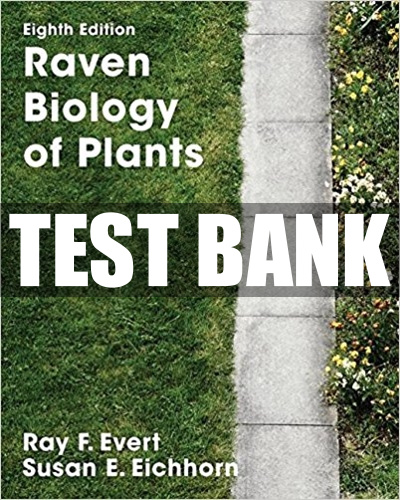- You cannot add another "Health Promotion Throughout the Life Span 8th Edition Test Bank" to your cart. View cart
Test Bank for Raven Biology of Plants 8th Edition
$35
Description
Test Bank for Raven Biology of Plants, 8th Edition
1. In science when general principles are arrived at from the examination of specific
hypotheses (cases), it is called (1 point)
a. inductive reasoning.
b. deductive reasoning.
c. theory.
d. controlled testing.
e. scientific method.
2. Which of the following characteristics are not necessary to being
“alive”? (1 point)
a. order
b. sensitivity
c. growth, development, and reproduction
d. regulation
e. movement
3. Science is not based on (1 point)
a. reasoning.
b. observations.
c. biased opinions.
d. experimental testing.
e. using results to rule out alternate hypothesis.
4. After Darwin concluded his voyage on the Beagle, he proposed that the process of
natural selection was the mechanism for (1 point)
a. artificial selection.
b. evolution.
c. sexual selection.
d. speciation.
e. overpopulation of finches on the Galapagos Islands.
5. After making careful observations, scientists construct a(n) (1 point)
a. experiment.
b. hypothesis.
c. conclusion.
d. theory.
e. data set.
6. The area of science that studies life and its processes is called (1 point)
a. biology.
b. astronomy.
c. geology.
d. archeology.
e. anthropology.
7. A hypothesis can be tested with (1 point)
a. an observation.
b. an experiment.
c. inductive reasoning.
d. deductive reasoning.
e. a question.
8. The method of reasoning that uses construction of general principles by careful
examination of many specific cases is called (1 point)
a. deductive reasoning.
b. theoretical reasoning.
c. hypothetical reasoning.
d. inductive reasoning.
e. experimental reasoning.
9. Birth and death rates of populations are not constant with time. If the birth rate
exceeds the death rate, then the population increases with time. If the death rate
exceeds the birth rate, the population decreases with time. Death rates can
change unexpectedly due to all of the following conditions except (1 point)
a. disease.
b. advances in medicine.
c. fertility rates.
d. war.
10. Why was the determination of the actual sequence of the human genome
considered to be descriptive science? (1 point)
a. It involved hypothesis-driven research.
b. It did not involve hypothesis-driven research.
c. It involved deductive reasoning.
d. It did not involve deductive reasoning.
11. You have been assigned to analyze some extraterrestrial material recently
collected from Mars. After examining a sample using a microscope you jump up
excitedly and shout to your colleagues that you have confirmed the existence of
life on Mars. One of your colleagues takes a look at your sample and remarks that
all he sees is a single-celled blob with little internal structure. Assuming that life
on Mars can be classified into similar domains and kingdoms as Earth, to which
domain does your blob belong? (1 point)
a. bacteria
b. fungi
c. protista
d. archea
12. You have been assigned to address a problem of overpopulation of species X in a
nearby county. One of the members of your team suggests introducing species Y,
which is a natural predator of species X, but not normally found in the area. After
some discussion, you go ahead and introduce species Y. What aspects of the
hierarchical organization may be affected within a period of a several years? (1
point)
a. population, species, community
b. population, community
c. population, species, community, biosphere
d. organism, population, species
13. While you are riding the ski lift up to the top of the mountain on a very cold day you
start to shiver involuntarily. You know that the shivering is your body′s attempt to
help regulate your body temperature and is an example of what type of
mechanism? (1 point)
a. energy utilization
b. sensitivity
c. homeostasis
d. evolutionary adaptation
14. You are interested in studying the function of GABAA receptors and how certain
deficits in GABAA receptor signaling result in anxiety-related behaviors in humans.
Since many of the experiments you want to do cannot be performed on humans,
you choose to study these processes in mice. In this case, mice can be considered
what type of experimental organism? (1 point)
a. a variable
b. a control
c. an applied
d. a model
15. An alien from another planet landed on earth. He is fascinated by cars and is
determined to figure out how they work. He decides to disassemble one of them
and examine each part independently. He removes one of the tires and proceeds to
learn all he can about the tire. He then removes one of the headlights and
proceeds to learn all he can about the headlight. What type of approach is this
alien taking to learn about the car? (1 point)
a. reductionism
b. deductive reasoning
c. inductive reasoning
d. irerativism
16. The cell theory is one of the foundations of biology. Which of the following
statements is not consistent with this theory? (1 point)
a. All organisms are made up of more than one cell.
b. Cells arise from other cells through the process of cell division.
c. Cells carry genetic material passed to daughter cells during cellular division.
d. Energy flow (metabolism and biochemistry) occurs within cells.
17. Phylogenetic analysis has revealed that in vertebrates and insects, eyes are
analogous, rather than homologous, structures. Interestingly, however, more
recent molecular genetic analysis determined
You must be logged in to post a review.



Reviews
There are no reviews yet.